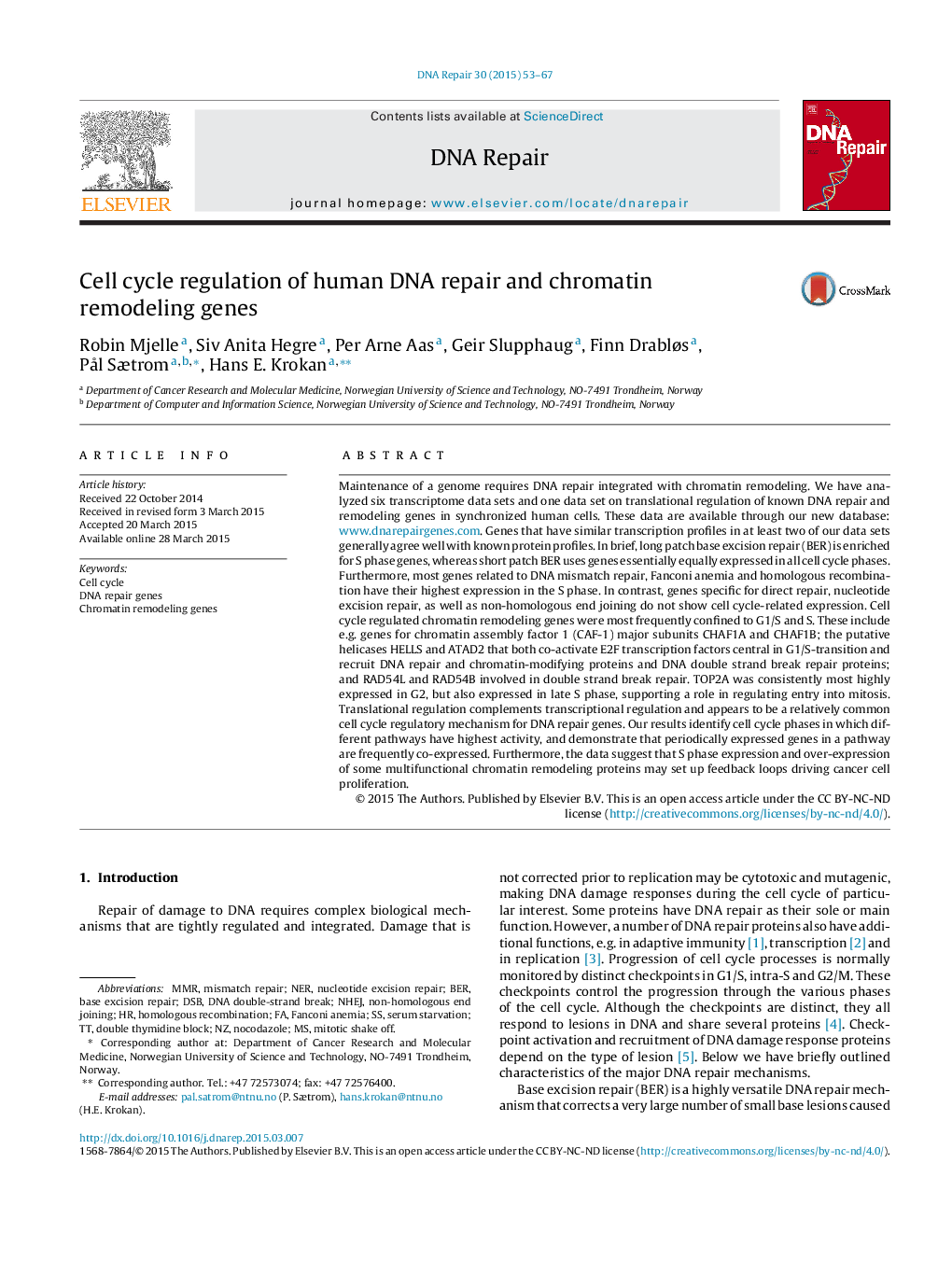| کد مقاله | کد نشریه | سال انتشار | مقاله انگلیسی | نسخه تمام متن |
|---|---|---|---|---|
| 8320613 | 1539398 | 2015 | 15 صفحه PDF | دانلود رایگان |
عنوان انگلیسی مقاله ISI
Cell cycle regulation of human DNA repair and chromatin remodeling genes
دانلود مقاله + سفارش ترجمه
دانلود مقاله ISI انگلیسی
رایگان برای ایرانیان
کلمات کلیدی
DSBNHEJBERMMRNER - DOWNnucleotide excision repair - تعمیر مجدد نوکلئوتیدیmismatch repair - تعمیر ناسازگاریbase excision repair - تعمیر پایه پایهDNA double-strand break - شکست دو رشته DNAnon-homologous end joining - عدم پیوستن انتهای غیر همولوگHomologous recombination - نوترکیبی همولوگnocodazole - نوکودازولCell cycle - چرخه سلولیDNA repair genes - ژن های ترمیم DNAFanconi anemia - کم خونی FanconiSerum starvation - گرسنگی سرم
موضوعات مرتبط
علوم زیستی و بیوفناوری
بیوشیمی، ژنتیک و زیست شناسی مولکولی
زیست شیمی
پیش نمایش صفحه اول مقاله

چکیده انگلیسی
Maintenance of a genome requires DNA repair integrated with chromatin remodeling. We have analyzed six transcriptome data sets and one data set on translational regulation of known DNA repair and remodeling genes in synchronized human cells. These data are available through our new database: www.dnarepairgenes.com. Genes that have similar transcription profiles in at least two of our data sets generally agree well with known protein profiles. In brief, long patch base excision repair (BER) is enriched for S phase genes, whereas short patch BER uses genes essentially equally expressed in all cell cycle phases. Furthermore, most genes related to DNA mismatch repair, Fanconi anemia and homologous recombination have their highest expression in the S phase. In contrast, genes specific for direct repair, nucleotide excision repair, as well as non-homologous end joining do not show cell cycle-related expression. Cell cycle regulated chromatin remodeling genes were most frequently confined to G1/S and S. These include e.g. genes for chromatin assembly factor 1 (CAF-1) major subunits CHAF1A and CHAF1B; the putative helicases HELLS and ATAD2 that both co-activate E2F transcription factors central in G1/S-transition and recruit DNA repair and chromatin-modifying proteins and DNA double strand break repair proteins; and RAD54L and RAD54B involved in double strand break repair. TOP2A was consistently most highly expressed in G2, but also expressed in late S phase, supporting a role in regulating entry into mitosis. Translational regulation complements transcriptional regulation and appears to be a relatively common cell cycle regulatory mechanism for DNA repair genes. Our results identify cell cycle phases in which different pathways have highest activity, and demonstrate that periodically expressed genes in a pathway are frequently co-expressed. Furthermore, the data suggest that S phase expression and over-expression of some multifunctional chromatin remodeling proteins may set up feedback loops driving cancer cell proliferation.
ناشر
Database: Elsevier - ScienceDirect (ساینس دایرکت)
Journal: DNA Repair - Volume 30, June 2015, Pages 53-67
Journal: DNA Repair - Volume 30, June 2015, Pages 53-67
نویسندگان
Robin Mjelle, Siv Anita Hegre, Per Arne Aas, Geir Slupphaug, Finn Drabløs, Pål Sætrom, Hans E. Krokan,